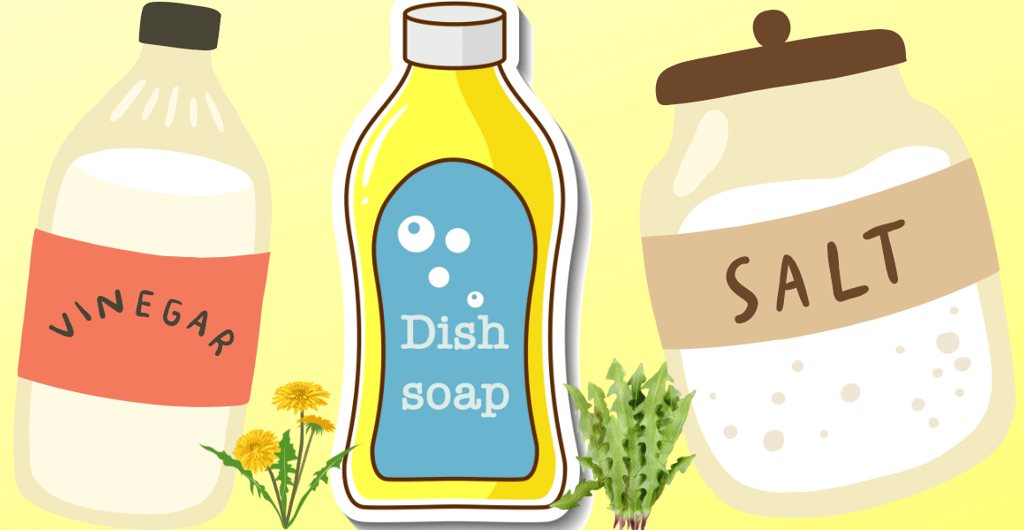3-Ingredient Homemade Weed Killer
Opting for a 3-ingredient homemade weed killer not only marks a significant departure from traditional chemical herbicides but also fosters a healthier garden ecosystem.
RECIPES


Starting with a Personal Story
Growing up in the serene countryside, gardening was more than just a hobby; it was a way of life. The smell of fresh soil, the vibrant colors of blooming flowers, and the satisfaction of harvesting homegrown vegetables—these experiences shaped my childhood. Our backyard was a lush sanctuary, teeming with a variety of plants meticulously tended to by my parents. However, one persistent challenge always threatened the beauty of our garden: weeds.
Despite their relentless efforts with conventional weed killers, my parents could not fully eradicate these unwelcome guests. It seemed that each stubborn weed removed was met with two more in its place. This ongoing battle left a lasting impression on me, fueling my desire for a better solution. I often reminisced about those endless summer afternoons spent pulling out weeds, always wondering if there was a more natural, effective approach that could simplify the process.
Years later, as an adult with my own garden, the same problems persisted. Determined to maintain a lush, healthy greenhouse without relying on harmful chemicals, I embarked on a mission to discover a natural weed killer. My research led me to some surprising revelations. I found that the solution didn't require complicated mixtures or toxic substances. Instead, it was about leveraging simple, natural ingredients found in most households.
With a newfound understanding, I began experimenting with various combinations until I stumbled upon the perfect formula—a 3-ingredient homemade weed killer. The results were transformative. My garden was thriving, free from the persistent grip of weeds, and safely cultivated without any chemical additives. This discovery not only revolutionized my gardening practices but also deepened my connection to nature, reinforcing the importance of sustainable and environmentally friendly solutions.
This journey from battling weeds with conventional methods to embracing a natural alternative has been profoundly gratifying. It’s a testament to the simplicity and effectiveness of natural solutions in maintaining a beautiful, healthy garden—one that I am excited to share with fellow gardening enthusiasts.
The Growing Problem with Weeds
Garden weeds are a ubiquitous challenge faced by gardeners worldwide. These persistent invaders can quickly turn a well-tended garden into a chaotic mess. Weeds compete with garden plants for essential resources such as sunlight, water, and nutrients. This competition can significantly stunt the growth of desired plants, leading to a less thriving garden and, in severe cases, the death of cherished flowers or vegetables.
The problem with weeds is not only their rapid growth but also their adaptability. Many weed species are incredibly resilient, with the ability to sprout from the smallest fragments left behind after removal. This tenacity makes them difficult to eradicate completely and often requires ongoing management. Additionally, some weeds are aggressive spreaders, capable of producing a vast number of seeds that can lay dormant in the soil, ready to sprout when conditions are favorable.
The frustrations gardeners feel towards weeds are thus well-founded. Despite dedicated care and maintenance, a sudden influx of weeds can swiftly overshadow all the hard work. Weeds are not only unsightly but also deter the aesthetic appeal of a well-manicured garden. For many, the constant battle with these unwelcome plants can feel overwhelmingly endless, making gardening more of a chore than a pleasure.
Beyond the immediate garden, weeds can have broader ecological impacts. They can disrupt local ecosystems by outcompeting native plants, decreasing biodiversity, and disturbing the balance of natural habitats. This disruption can extend to wildlife, as many animals and insects rely on specific plants for food and shelter. Therefore, controlling weeds is not just about maintaining a beautiful garden but also about contributing to the health and sustainability of the wider environment.
Because of these reasons, many gardeners seek effective solutions to mitigate weed growth without harming their gardens and the surrounding ecosystem. One popular method gaining attention is the use of a homemade weed killer made from just three ingredients.
Why Go Natural?
In today's world, the pursuit of a beautiful, well-manicured lawn often leads homeowners to rely on commercial weed killers. While these products are effective, they come with significant drawbacks. One primary concern is their harmful effects on the environment. Many commercial weed killers contain chemicals that can seep into the soil, contaminating groundwater and harming beneficial insects and wildlife. Birds, bees, and other pollinators are particularly vulnerable to these toxic substances, disrupting ecosystems and biodiversity.
Moreover, commercial weed killers pose a threat to pets and children. The chemical residues left on treated lawns can be ingested through play, leading to potential health issues. Dogs and cats are at risk as they traverse and groom themselves after wandering through treated areas, while children are susceptible through hand-to-mouth activities. It becomes apparent that the convenience of these products is overshadowed by their numerous hazards.
This brings us to the need for safer, more eco-friendly alternatives. Natural solutions offer an effective way to manage weeds without compromising the safety of our environment, pets, and families. Homemade weed killers are simple to make, cost-effective, and environmentally sustainable. By utilizing readily available ingredients, we can achieve a weed-free garden while maintaining ecological balance.
Personally, my journey toward natural weed control began when I noticed the dwindling number of butterflies in my yard. Concerned for their declining habitat, I researched the impact of synthetic chemicals and decided to explore homemade weed killers. The transition was not only beneficial for the environment but also gave me peace of mind, knowing that my garden is a safe space for both wildlife and my loved ones.
Embracing natural alternatives to maintain our gardens aligns with a broader commitment to sustainability and conscientious living. It's a small step that collectively makes a significant difference, ensuring that our green spaces are safe and flourishing for future generations.
The 3 Magic Ingredients
The key to creating a powerful homemade weed killer rests in three everyday ingredients: vinegar, salt, and dish soap. Each of these components plays a unique role in combating weeds, making them a highly effective trio when combined.
Vinegar
The first ingredient is vinegar, which contains acetic acid. This acid is effective in killing weeds by drawing moisture out of the plant, causing it to dry up and die. White vinegar, commonly found in most households, works perfectly for this purpose.
Salt
Next is salt. Salt dehydrates plants by disrupting the water balance in their cells. This dehydration process weakens the weed, making it even less likely to survive. Table salt, which is readily available, can be used in this mixture.
Dish Soap
The final ingredient is dish soap. While it might seem like an unusual addition, dish soap acts as a surfactant. This means it helps the vinegar and salt adhere better to the weeds by breaking down the plant’s outer waxy layer, allowing the other ingredients to penetrate more effectively.
Combining the Ingredients
Now, let's put these three ingredients together. Here are the quantities and steps required to create your homemade weed killer:
2 cups of white vinegar
2 tablespoons of salt
1 teaspoon of dish soap
Follow these simple steps:
Pour the 2 cups of white vinegar into a spray bottle.
Add the 2 tablespoons of salt to the vinegar. Shake the bottle gently until the salt fully dissolves.
Next, add 1 teaspoon of dish soap to the mixture. Shake the spray bottle again to ensure the dish soap is well mixed.
And there you have it – a homemade, effective weed killer made from just three ingredients. When applying, spray directly on the weeds, making sure to cover the entire plant. This simple mixture makes it easy to tackle those unwanted garden invaders in an eco-friendly manner.
Application Tips for Best Results
When it comes to applying your 3-ingredient homemade weed killer, timing and technique play pivotal roles in its effectiveness. For optimal performance, it is highly recommended to apply the mixture on a sunny day. The heat and direct sunlight enhance the efficacy of this natural herbicide by helping it penetrate the weeds more deeply, expediting their breakdown and ultimately leading to a quicker demise. Make sure the day is both sunny and dry, as rain can dilute the solution, rendering it less effective.
A useful tip from personal experience is to choose mid-morning for your weed-killing activities. By this time, any morning dew will have evaporated, reducing the risk of the weed killer being washed off. Additionally, applying the solution during a period of sustained sunny weather—meaning a day or two without rain—is ideal. This allows ample time for the weed killer to take full effect without being disrupted by sudden showers.
Precision is key when applying your homemade weed killer. Use a spray bottle or garden sprayer to ensure even distribution. Target the base of the weeds, directing the spray towards the roots to maximize the impact. Avoid spraying on windy days to prevent unintended drift onto desirable plants, as the mixture can harm them as well.
Through trial and error, I've found that reapplying the solution every few days until the weed is completely eliminated can be highly effective. Each garden is unique, and factors like the type of weeds you're dealing with and soil conditions can influence the results. Therefore, feel free to experiment with different application intervals and note what yields the best outcome for your specific garden.
By adhering to these application tips and refining your approach based on personal observations, you can achieve superior weed control with this simple, yet powerful homemade solution.
A Garden Free of Harmful Chemicals
Opting for a 3-ingredient homemade weed killer not only marks a significant departure from traditional chemical herbicides but also fosters a healthier garden ecosystem. When you switch to a natural weed killer, you substantially reduce the risks associated with toxic substances that could harm beneficial insects, pets, and the overall soil quality. This shift promotes biodiversity, supporting a balanced environment where plants and insects can coexist harmoniously.
One of the most noticeable benefits I've observed since transitioning to a natural weed killer is the improved health of my garden. The absence of harsh chemicals has led to more vibrant plants and a noticeable increase in pollinators like bees and butterflies. Additionally, the soil appears richer and more fertile, making it easier for plants to flourish. These changes underline the fact that a natural approach to weed control not only eliminates unwanted plants but also nourishes desirable ones.
Moreover, using a homemade weed killer ensures that your gardening practices align with sustainable principles. By relying on simple, non-toxic ingredients easily found at home, you contribute to reducing the chemical footprint on the environment. This also translates to a safer space for children and pets to explore, as there are no harmful residues left behind.
I hope this encourages you to embrace more sustainable gardening practices. The promise of a thriving, weed-free garden using a natural weed killer is not just an achievable dream but a rewarding reality. By making this eco-friendly choice, you pave the way for a healthier garden and a more sustainable future. Your garden can indeed become a lush, inviting oasis, all while maintaining the delicate balance of nature.
Support@rusticrootshomestead.com
© 2024 Rustic Roots Homestead - All rights reserved.
